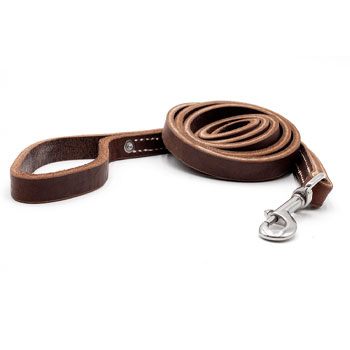Build Your Own Bloodline Through a Foster Home Program
Note: Leerburg formerly bred working German Shepherds until deciding to shift its focus towards producing dog training videos and courses alongside providing quality dog training equipment. This article was written while our breeding program was still active. While Leerburg no longer breeds working GSDs, we believe this article may still provide valuable information for those interested in starting their own breeding program.
In the early 1980s, I went to dinner with a man named Walter Martin. Walter was one of the premier breeders in the history of show quality German Shepherds (Walter has since passed). His kennel name was Wienerau Kennels and it was located in Germany. We talked about breeding the entire night. There was one thing Walter told me that burned a hole in my mind. He said, "If you want to build a bloodline, you need to breed a minimum of 10 litters a year." Even though he and I had totally different goals in a breeding program (he bred show dogs and my interest was strictly in working dogs), that one rule of thumb has proven to be true.
I already knew that people do not go out and build a bloodline by only breeding one or two litters a year. In 1980, I had been trying that approach for 5 years and it did not work.
There are too many variables in breeding. Just because you have a very good Sch 1 bitch and breed it to a very good Sch 3 male does not mean that you will get a very good litter. That has been proven a million times over the years. Like Walter said, "No matter how good you are, you will still make mistakes." That's why a breeder needs to breed a number of litters if he is looking to produce a few really good dogs.
For the average person, it is impossible to raise and keep enough bitches to breed 10 litters a year. Not only do you have to have kennel space for them, but you also need to pay to feed them and pay to have someone clean up after them. Even if you have all of the above (which I don't mind doing), it is not fair to leave a dog confined to a kennel run with no human contact except to feed and clean the run. That is the reason I developed my FOSTER HOME program.
The following information contains the details on how you can build your own breeding program and bloodline. This program has been developed at Leerburg Kennels and is currently operating with over 40 German Shepherd females enrolled.

How the Program Works
We place our breeding females in selected foster homes. These females are either bitches that have been purchased or they are the pick of the litter female puppies that we select to keep back to see if they are good enough to enter our breeding program.
The foster family pays nothing for the puppy. They do agree that the dog will live as a housedog. They agree to purchase a dog crate and a Flexi Lead. They also have access to all of our training videos on a no-charge basis.
We are very selective in who we choose to become a foster family. The foster parents go through a detailed selection process. The ideal person is one who has just had a 10 or 11-year-old dog that has died of old age. This is a person who knows how to take care of a dog. We do not give dogs to people that want farm dogs, nor do we give people dogs that are going to keep them in an outside dog kennel. We also do not give dogs to people who have just had a dog that was accidentally killed (if it happened once, it can happen again).
Another important point to consider is not to allow the dogs to be placed in homes further than 50 miles away. We have learned that allowing the dogs to go further than 50 miles only creates problems in the long run. You do not see the dog enough and it is always a major concern to have the dog brought back for breeding and whelping.
We sign the AKC ownership of the dogs over to the foster parents at the same time we sign a breeding contract with them. We have full breeding rights. We can breed when we want. The foster parents sign a breeding lease agreement, so they are registered as Ed Frawley being the breeder. Should the people spay the dog or refuse to allow us to breed the dog, they agree to pay for two litters of 6 pups at $1,800.00 each. If you do the math, you see that there is a considerable penalty if they choose to disregard our agreement. This has never happened though.
When we no longer wish to breed the dog, the foster parents are required to spay the dog and provide a letter from their vet confirming the spay was complete.
In addition, if the foster parents do not tell us when a bitch comes in season (even if we do not plan on breeding it), they are liable for the price of a litter.
We have a computer program to track the female's heat cycles. By inputting every heat cycle, we can anticipate which bitches are going to come in season in which month. This allows us to plan a breeding season around a computer printout. That is the reason I will take a bitch away if the foster parent does not tell me about a heat cycle. I also feel that this rule forces people to be more aware of what is going on with their dogs. They end up noticing other problems that come up besides heat cycles.
As a puppy grows up, we monitor their temperament. We either go to the foster home or ask that the pups be brought to the kennel occasionally. We give DHL-Parvo shots, Lyme's shots, and worm the foster dogs here at the kennel. There is no charge for this. This is an incentive for the foster parents to stop by every now and then. When the dog is 2 years old, we pay for the OFA x-rays. If there is something we do not like about a female (either in temperament, structure, or in the hip x-ray), we ask the foster parents to have the dog spayed and we wash the dog out of the program.
If it is determined that a bitch is suitable for breeding, it will be bred here at the kennel. It comes here, gets bred, and then goes home again. It then comes back to the kennel (5 days before whelping) to have the puppies. When it weans the pups (usually at 6 weeks), it goes back to the foster home. It is important to make sure the female stays at the kennel for 4 or 5 days after it is taken off the litter. Some bitches go through extreme separation problems and will run away from the foster home if they were allowed to go home right after they come off of the littler.
The most we breed a female is one time each year. In many cases, we do not even breed them that much. Our goal is to breed 12 to 15 litters of dogs per year. When you have 40 or more bitches to choose from, there are a lot of females that do not get bred every year.
When we reach a point where the quality of puppies from a particular foster dog is not as good as the majority of the breeding stock, we will drop the female from the breed list and ask the foster parents to have the dog spayed and it then becomes their dog.
By constantly adding and subtracting dogs from the breed list, we are continually able to improve the bloodline. Usually, we will breed a bitch twice to two different stud dogs before we would drop it off the list. The decision to drop a bitch would be made on the quality of the puppies she produced. The problem is, you need to wait a while to monitor the development of a litter before deciding if the litter is "Very Good", "Good", or "Could be Better".
Responsibilities of the Foster Home
The foster parents are required to feed good quality food. We feed a raw diet at Leerburg but we know it can be time-consuming to maintain. We have compiled a list of kibble alternatives that are grain-free and all-natural.
The foster parents are required to keep the dogs current on rabies, and heartworm. The reason for this is that the state of Wisconsin does not allow me to give rabies shots or administer heartworm medication. We ask that the dogs be put on once-a-month heartworm pills during the mosquito season.
Foster parents will be expected to have a dog crate of some kind in their home. Dog crates are used to housebreak dogs. We do not place dogs in homes where the dogs are allowed to run loose. That is just asking to have accidents and valuable articles chewed up.
If at any time something changes in a foster home and they are no longer able to keep a foster dog, there is no problem with them returning the dog back to the kennel. When this happens, we will either place the dog in a new foster home or we will sell the dog, depending on the quality of her and her pups.
It is very difficult to find good foster homes. We run ads in two local newspapers everyday year-round. We take 20 to 30 calls for every dog we place. You will find that the hardest part of the program is finding good homes. It is almost easier to put out the older dogs that are returned than the pups. They are house trained and most have some form of obedience.
When people ask if I split the litter with foster parents, the answer is usually "no." The only way I ever consider splitting a litter with a foster parent is if the person puts a Schutzhund title on the dog. That is a rule that is cast in stone. Most foster parents find the pups cute, but they don't want more dogs. The kind of people that take these dogs are not interested in breeding. If they are good foster parents and want another dog, I will give them a second one. I have 3 people with 2 dogs.
Any negative comments I have ever heard about not splitting litters have come from people that are not in the program. These people think it is not fair to let another person raise a dog and then I take all the pups from "the dog". My position is that there are a lot of people in the world that have no interest in breeding, that make absolutely great pet owners (foster parents), that would never in their life consider paying $1,000.00 for a puppy. For many they cannot afford it, for the rest, a $1,000.00 pet is not a priority for them. These people appreciate having a quality pet live in their home and the fact that I occasionally take a litter is of no concern to them, especially when they see the quality of my kennel facility. They know the dog is well taken care of when it comes here.
If a person is interested in breeding, then this is not a program for them. They should purchase a dog and get into the business.
We also get asked by an occasional foster parent if they can whelp a litter at their home. The answer is "NO". There is too much that can go wrong during delivery. I convince them of this by letting them watch the video I have produced titled "Whelping Puppies". That usually does the trick.
From a breeder's standpoint, the only negative aspect of this program is the fact that you give up the sale of a puppy at the time that you place it in a home. You also do not have the option to sell the foster dogs if and when people call and want to buy older females. But after you have been in the program for a couple of years, this will prove to be a small price to pay. The program grows exponentially. You can easily find that if you foster several females a year, after 6 years, you have all the females you need.
It is my opinion that more people in this country should start programs like this. If we are to improve the breed of dogs (and it does not matter what breed we are talking about), we need to improve the way we breed. This program works. I know it does because I have some 4th generation dogs that are better than their grandparents.









Ask Cindy.